1. Laganà P, Coniglio MA, Corso C, Turco VL, Dattilo G, Delia S. Mediterranean diet, sport and health. Prog Nutr. 2020; 22:e2020045.
2. Devrim-Lanpir A, Hill L, Knechtle B. Efficacy of popular diets applied by endurance athletes on sports performance: beneficial or detrimental? A narrative review. Nutrients. 2021; 13:491. PMID:
33540813.

3. Malsagova KA, Kopylov AT, Sinitsyna AA, Stepanov AA, Izotov AA, Butkova TV, Chingin K, Klyuchnikov MS, Kaysheva AL. Sports nutrition: diets, selection factors, recommendations. Nutrients. 2021; 13:3771. PMID:
34836029.

4. Adam S, Pasodi MS. Nutrition practice and its impact on performance of sports persons. Int J Health Phys Educ Comput Sci Sport. 2019; 35:141–144.
5. Anderson JJ, Nieman DC. Diet quality—the Greeks had it right! Nutrients. 2016; 8:636. PMID:
27754409.

6. Pimentel D, Pimentel M. Sustainability of meat-based and plant-based diets and the environment. Am J Clin Nutr. 2003; 78:660S–3S. PMID:
12936963.

7. Meyer NL, Reguant-Closa A, Nemecek T. Sustainable diets for athletes. Curr Nutr Rep. 2020; 9:147–162. PMID:
32504413.

8. Serra-Majem L, Tomaino L, Dernini S, Berry EM, Lairon D, Ngo de la Cruz J, Bach-Faig A, Donini LM, Medina FX, Belahsen R, et al. Updating the Mediterranean diet pyramid towards sustainability: focus on environmental concerns. Int J Environ Res Public Health. 2020; 17:8758. PMID:
33255721.

9. Dernini S, Berry EM. Mediterranean diet: from a healthy diet to a sustainable dietary pattern. Front Nutr. 2015; 2:15. PMID:
26284249.

10. Barnard ND, Goldman DM, Loomis JF, Kahleova H, Levin SM, Neabore S, Batts TC. Plant-based diets for cardiovascular safety and performance in endurance sports. Nutrients. 2019; 11:130. PMID:
30634559.

11. Merra G, Noce A, Marrone G, Cintoni M, Tarsitano MG, Capacci A, De Lorenzo A. Influence of Mediterranean diet on human gut microbiota. Nutrients. 2020; 13:7. PMID:
33375042.

12. Barnett A. Using recovery modalities between training sessions in elite athletes: does it help? Sports Med. 2006; 36:781–796. PMID:
16937953.
13. Monedero J, Donne B. Effect of recovery interventions on lactate removal and subsequent performance. Int J Sports Med. 2000; 21:593–597. PMID:
11156281.

14. Chang CC, Chen CW, Owaga E, Lee WT, Liu TN, Hsieh RH. Mangosteen concentrate drink supplementation promotes antioxidant status and lactate clearance in rats after exercise. Nutrients. 2020; 12:1447. PMID:
32429510.

15. Patlar S, Baltaci AK, Mogulkoc R, Gunay M. Effect of vitamin C supplementation on lipid peroxidation and lactate levels in individuals performing exhaustion exercise. Ann Appl Sport Sci. 2017; 5:21–27.

16. Wu L, Sun Z, Zhao J, Guo X, Wang J. Effect of astaxanthin supplementation on antioxidant capacity, blood lactate and blood uric acid metabolism in human recovery stage after exercise. Adv Biosci Bioeng. 2019; 7:60.

17. Chycki J, Kurylas A, Maszczyk A, Golas A, Zajac A. Alkaline water improves exercise-induced metabolic acidosis and enhances anaerobic exercise performance in combat sport athletes. PLoS One. 2018; 13:e0205708. PMID:
30452459.

18. Yalcinkaya N, Cetin O, Beyleroglu M, Isik O, Eker S, Bilge M. Effect of alkaline diet with 8-week step aerobic exercise on body composition and aerobic exercise performance of sedentary women. Prog Nutr. 2020; 22:11–18.
19. Schwalfenberg GK. The alkaline diet: is there evidence that an alkaline pH diet benefits health? J Environ Public Health. 2012; 2012:727630. PMID:
22013455.

20. Fatahi S, Varkaneh HK, Azadbakht L. Association between dietary acid load with alternative Mediterranean diet and dietary approaches to stop hypertension among Tehranian women. J Adv Biomed Sci. 2018; 8:1036–1045.
21. Applegate C, Mueller M, Zuniga KE. Influence of dietary acid load on exercise performance. Int J Sport Nutr Exerc Metab. 2017; 27:213–219. PMID:
28050921.

22. Baker ME, DeCesare KN, Johnson A, Kress KS, Inman CL, Weiss EP. Short-term Mediterranean diet improves endurance exercise performance: a randomized-sequence crossover trial. J Am Coll Nutr. 2019; 38:597–605. PMID:
30758261.

23. Philippou E, Middleton N, Pistos C, Andreou E, Petrou M. The impact of nutrition education on nutrition knowledge and adherence to the Mediterranean diet in adolescent competitive swimmers. J Sci Med Sport. 2017; 20:328–332. PMID:
27692575.

24. Caciano SL, Inman CL, Gockel-Blessing EE, Weiss EP. Effects of dietary acid load on exercise metabolism and anaerobic exercise performance. J Sports Sci Med. 2015; 14:364–371. PMID:
25983586.
25. Limmer M, Eibl AD, Platen P. Enhanced 400-m sprint performance in moderately trained participants by a 4-day alkalizing diet: a counterbalanced, randomized controlled trial. J Int Soc Sports Nutr. 2018; 15:25. PMID:
29855319.

26. Ríos Enríquez O, Guerra-Hernández E, Feriche Fernández-Castanys B. Effects of the metabolic alkalosis induced by the diet in the high intensity anaerobic performance. Nutr Hosp. 2010; 25:768–773. PMID:
21336434.
27. Remer T, Manz F. Estimation of the renal net acid excretion by adults consuming diets containing variable amounts of protein. Am J Clin Nutr. 1994; 59:1356–1361. PMID:
8198060.

28. Kerksick CM, Fox E. Sports Nutrition Needs for Child and Adolescent Athletes. Boca Raton (FL): CRC Press;2016.
29. Merdol TK. Standard Meal Schedules. Ankara: Hatipoğlu Publisher;2003.
30. Kılıç P, Pekcan G. Reference values of handgrip strength for healthy adults. J Nutr Diet. 2012; 40:32–42.
31. Balsalobre-Fernández C, Glaister M, Lockey RA. The validity and reliability of an iPhone app for measuring vertical jump performance. J Sports Sci. 2015; 33:1574–1579. PMID:
25555023.

32. Coburn JW. Measuring power. Strength Condit J. 2012; 34:25–28.

33. Mayorga-Vega D, Aguilar-Soto P, Viciana J. Criterion-related validity of the 20-m shuttle run test for estimating cardiorespiratory fitness: a meta-analysis. J Sports Sci Med. 2015; 14:536–547. PMID:
26336340.
34. Léger LA, Mercier D, Gadoury C, Lambert J. The multistage 20 metre shuttle run test for aerobic fitness. J Sports Sci. 1988; 6:93–101. PMID:
3184250.

35. Borg GA. Psychophysical bases of perceived exertion. Med Sci Sports Exerc. 1982; 14:377–381. PMID:
7154893.

36. Fleming N, Vaughan J, Feeback M. Ingestion of oxygenated water enhances lactate clearance kinetics in trained runners. J Int Soc Sports Nutr. 2017; 14:9. PMID:
28360825.

37. Baysal A, Aksoy M, Besler HT, Bozkurt N, Keçecioğlu S, Merdol TK, et al. Diet Handbook. Ankara: Hatipoğlu Press;2008.
38. Pekcan G. Determination of Nutritional Status. Ankara: Ministry of Health Press;2012.
39. Caccialanza R, Cameletti B, Cavallaro G. Nutritional intake of young Italian high-level soccer players: under-reporting is the essential outcome. J Sports Sci Med. 2007; 6:538–542. PMID:
24149489.
40. Russell M, Pennock A. Dietary analysis of young professional soccer players for 1 week during the competitive season. J Strength Cond Res. 2011; 25:1816–1823. PMID:
21478767.

41. Briggs MA, Cockburn E, Rumbold PL, Rae G, Stevenson EJ, Russell M. Assessment of energy intake and energy expenditure of male adolescent academy-level soccer players during a competitive week. Nutrients. 2015; 7:8392–8401. PMID:
26445059.

42. Kim SH, Oh CS, Lee JH. Dietary nutrient intake of Korean adolescent distance runners. J Exerc Rehabil. 2019; 15:781–786. PMID:
31938699.

43. Black AE. Dietary assessment for sports dietetics. Nutr Bull. 2001; 26:29–42.

44. Yannakoulia M, Aggelopoulou D, Skenderi K, Koinaki S, Yiannakouris N. A Mediterranean-like breakfast affects energy intake and appetite-related feelings. Int J Food Sci Nutr. 2014; 65:899–902. PMID:
25010358.

45. Aerenhouts D, Van Cauwenberg J, Poortmans JR, Hauspie R, Clarys P. Influence of growth rate on nitrogen balance in adolescent sprint athletes. Int J Sport Nutr Exerc Metab. 2013; 23:409–417. PMID:
23475076.

46. Peng W, Berry EM, Goldsmith R. Adherence to the Mediterranean diet was positively associated with micronutrient adequacy and negatively associated with dietary energy density among adolescents. J Hum Nutr Diet. 2019; 32:41–52. PMID:
30426577.

47. Serra-Majem L, Bes-Rastrollo M, Román-Viñas B, Pfrimer K, Sánchez-Villegas A, Martínez-González MA. Dietary patterns and nutritional adequacy in a Mediterranean country. Br J Nutr. 2009; 101(Suppl 2):S21–S28. PMID:
19594961.

48. Hietavala EM, Puurtinen R, Kainulainen H, Mero AA. Low-protein vegetarian diet does not have a short-term effect on blood acid-base status but raises oxygen consumption during submaximal cycling. J Int Soc Sports Nutr. 2012; 9:50. PMID:
23181739.

49. Campa F, Toselli S, Mazzilli M, Gobbo LA, Coratella G. Assessment of body composition in athletes: a narrative review of available methods with special reference to quantitative and qualitative bioimpedance analysis. Nutrients. 2021; 13:1620. PMID:
34065984.

50. Kuo KL, Chen HM, Hsiao SH, Chu D, Huang SJ, Huang KC, Huang CY. The relationship between anthropometric factors and hyperuricemia in adolescent athletes. Obes Res Clin Pract. 2021; 15:375–380. PMID:
33865745.

51. Altavilla C, Joulianos A, Comeche Guijarro JM, Caballero P. Adherence to the Mediterranean diet, is there any relationship with main indices of central fat in adolescent competitive swimmers? Arch Med Deporte. 2021; 38:113–118.

52. Gulati A, Jain R, Khan A, Dhingra M. Comparison of anthropometric parameters between Indian adolescent male swimmers and non-swimmers: a cross-sectional study. Eur J Phys Educ Sport Sci. 2021; 7:80–89.
53. Bacopoulou F, Landis G, Rentoumis A, Tsitsika A, Efthymiou V. Mediterranean diet decreases adolescent waist circumference. Eur J Clin Invest. 2017; 47:447–455. PMID:
28407234.

54. Natour N, Badrasawi M, Samouh M, Khodour R. Relationship between adherence to Mediterranean diet with, nutritional and physical fitness status among young athletes from football sports academy- Palestine. Ann Epidemiol Public Health. 2020; 3:1032.
55. Kurka JM, Buman MP, Ainsworth BE. Validity of the rapid eating assessment for patients for assessing dietary patterns in NCAA athletes. J Int Soc Sports Nutr. 2014; 11:42. PMID:
25302055.

56. Juzwiak CR, Amancio OM, Vitalle MS, Pinheiro MM, Szejnfeld VL. Body composition and nutritional profile of male adolescent tennis players. J Sports Sci. 2008; 26:1209–1217. PMID:
18645734.

57. Manzano-Carrasco S, Felipe JL, Sanchez-Sanchez J, Hernandez-Martin A, Clavel I, Gallardo L, Garcia-Unanue J. Relationship between adherence to the Mediterranean diet and body composition with physical fitness parameters in a young active population. Int J Environ Res Public Health. 2020; 17:3337. PMID:
32403376.

58. Martínez-Rodríguez A, Martínez-Olcina M, Hernández-García M, Rubio-Arias JÁ, Sánchez-Sánchez J, Lara-Cobos D, Vicente-Martínez M, Carvalho MJ, Sánchez-Sáez JA. Mediterranean diet adherence, body composition and performance in beach handball players: a cross sectional study. Int J Environ Res Public Health. 2021; 18:2837. PMID:
33802192.

59. Rubio-Arias JÁ, Ramos Campo DJ, Ruiloba Nuñez JM, Carrasco Poyatos M, Alcaraz Ramón PE, Jiménez Díaz FJ. Adherence to a Mediterranean diet and sport performance in a elite female athletes futsal population. Nutr Hosp. 2015; 31:2276–2282. PMID:
25929404.
60. Alacid F, Vaquero-Cristóbal R, Sánchez-Pato A, Muyor JM, López-Miñarro PÁ. Habit based consumptions in the Mediterranean diet and the relationship with anthropometric parameters in young female kayakers. Nutr Hosp. 2014; 29:121–127. PMID:
24483969.
61. Galan-Lopez P, Ries F, Gisladottir T, Domínguez R, Sánchez-Oliver AJ. Healthy lifestyle: relationship between Mediterranean diet, body composition and physical fitness in 13 to 16-years old Icelandic students. Int J Environ Res Public Health. 2018; 15:2632. PMID:
30477217.

62. Santos DA, Dawson JA, Matias CN, Rocha PM, Minderico CS, Allison DB, Sardinha LB, Silva AM. Reference values for body composition and anthropometric measurements in athletes. PLoS One. 2014; 9:e97846. PMID:
24830292.

63. Kasper AM, Langan-Evans C, Hudson JF, Brownlee TE, Harper LD, Naughton RJ, Morton JP, Close GL. Come back skinfolds, all is forgiven: a narrative review of the efficacy of common body composition methods in applied sports practice. Nutrients. 2021; 13:1075. PMID:
33806245.

64. Kürklü NS, Altun HK. Evaluation of healthy nutrition scores with different diet quality indices in faculty of sports science students. Turk J Sports Sci. 2021; 13:183–190.

65. Bučan Nenadić D, Kolak E, Selak M, Smoljo M, Radić J, Vučković M, Dropuljić B, Pijerov T, Babić Cikoš D. Anthropometric parameters and Mediterranean diet adherence in preschool children in split-Dalmatia county, Croatia-are they related? Nutrients. 2021; 13:4252. PMID:
34959811.

66. Bonaccorsi G, Lorini C, Santomauro F, Sofi F, Vannetti F, Pasquini G, Macchi C. Mugello Study Group. Adherence to Mediterranean diet and nutritional status in a sample of nonagenarians. Exp Gerontol. 2018; 103:57–62. PMID:
29274395.
67. Frisancho AR. New norms of upper limb fat and muscle areas for assessment of nutritional status. Am J Clin Nutr. 1981; 34:2540–2545. PMID:
6975564.

68. Seiquer I, Mesías M, Hoyos AM, Galdó G, Navarro MP. A Mediterranean dietary style improves calcium utilization in healthy male adolescents. J Am Coll Nutr. 2008; 27:454–462. PMID:
18978164.
69. Buchhorn R. Growth-promoting effects of omega-3-fatty acid supplementation in children with short stature. Ann Nutr Disord Ther. 2020; 7:1064.
70. Fang A, Li K, Li H, Guo M, He J, Shen X, Song J. Low habitual dietary calcium and linear growth from adolescence to young adulthood: results from the China Health and Nutrition Survey. Sci Rep. 2017; 7:9111. PMID:
28831091.

71. Samadi M, Moradi S, Azadbakht L, Rezaei M, Hojati N. Adherence to healthy diet is related to better linear growth with open growth plate in adolescent girls. Nutr Res. 2020; 76:29–36. PMID:
32151877.
72. Julián C, Huybrechts I, Gracia-Marco L, González-Gil EM, Gutiérrez Á, González-Gross M, Marcos A, Widhalm K, Kafatos A, Vicente-Rodríguez G, et al. Mediterranean diet, diet quality, and bone mineral content in adolescents: the HELENA study. Osteoporos Int. 2018; 29:1329–1340. PMID:
29508038.
73. Vatanparast H, Baxter-Jones A, Faulkner RA, Bailey DA, Whiting SJ. Positive effects of vegetable and fruit consumption and calcium intake on bone mineral accrual in boys during growth from childhood to adolescence: the University of Saskatchewan Pediatric Bone Mineral Accrual Study. Am J Clin Nutr. 2005; 82:700–706. PMID:
16155286.
74. Valtueña S, Sette S, Branca F. Influence of Mediterranean diet and Mediterranean lifestyle on calcium and bone metabolism. Int J Vitam Nutr Res. 2001; 71:189–202. PMID:
11582842.
75. Schtscherbyna A, Ribeiro BG, Fleiuss FM. Nutrition and Enhanced Sports Performance. Cambridge (MA): Academic Press;2019.
76. Ranković G, Mutavdžić V, Toskić D, Preljević A, Kocić M, Nedin Ranković G, Damjanović N. Aerobic capacity as an indicator in different kinds of sports. Bosn J Basic Med Sci. 2010; 10:44–48. PMID:
20192930.

77. Galan-Lopez P, Domínguez R, Pihu M, Gísladóttir T, Sánchez-Oliver AJ, Ries F. Evaluation of physical fitness, body composition, and adherence to Mediterranean diet in adolescents from Estonia: the AdolesHealth study. Int J Environ Res Public Health. 2019; 16:4479. PMID:
31739416.

78. Huyghe T, Calleja-Gonzalez J, Terrados N. Basketball Sports Medicine and Science. Berlin: Springer;2020.
79. Kuznetcov S, Chernogorov D, Matveev Y. Use of lactate as the main metabolic marker to control the functional state of the body during the preparation of weightlifters. J Phys Educ Sport. 2020; 20:2554–2559.
80. Chen HY, Cheng FC, Pan HC, Hsu JC, Wang MF. Magnesium enhances exercise performance via increasing glucose availability in the blood, muscle, and brain during exercise. PLoS One. 2014; 9:e85486. PMID:
24465574.

81. Choi SK, Baek SH, Choi SW. The effects of endurance training and thiamine supplementation on anti-fatigue during exercise. J Exerc Nutrition Biochem. 2013; 17:189–198.

82. Boyalı E, Nizamlıoğlu M, Patlar S. The effects of vitamin E application on some free radicals and lactate levels in acute exercise. Turk J Sport Exerc. 2012; 14:36–42.
83. Hietavala EM, Stout JR, Hulmi JJ, Suominen H, Pitkänen H, Puurtinen R, Selänne H, Kainulainen H, Mero AA. Effect of diet composition on acid-base balance in adolescents, young adults and elderly at rest and during exercise. Eur J Clin Nutr. 2015; 69:399–404. PMID:
25491498.

84. Arciero PJ, Miller VJ, Ward E. Performance enhancing diets and the PRISE protocol to optimize athletic performance. J Nutr Metab. 2015; 2015:715859. PMID:
25949823.

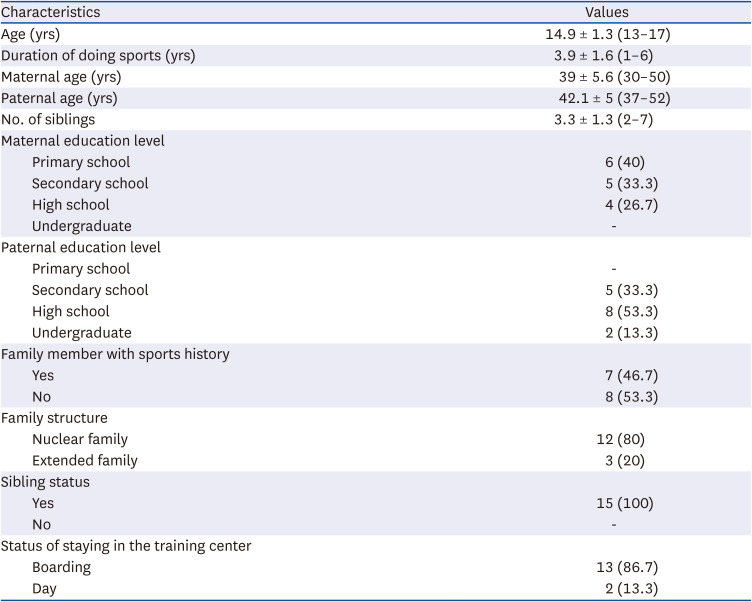
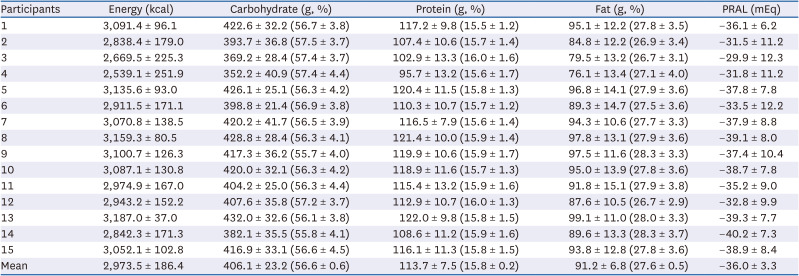
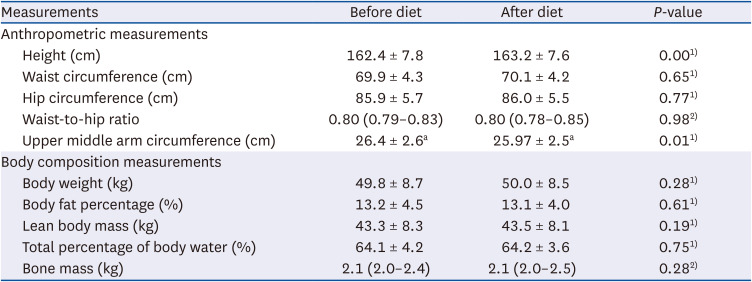
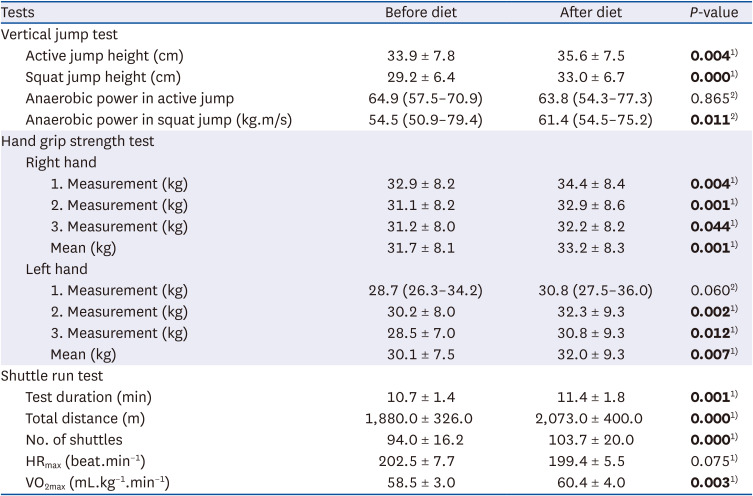
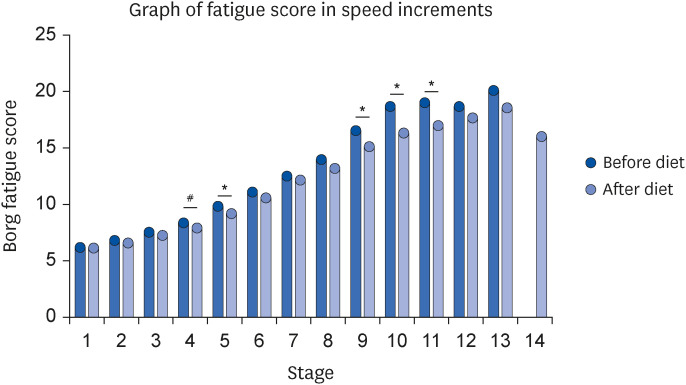




 PDF
PDF Citation
Citation Print
Print



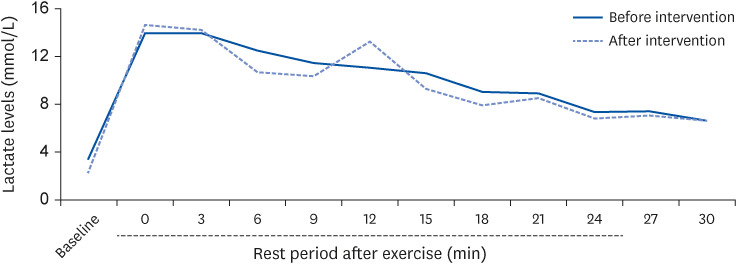

 XML Download
XML Download